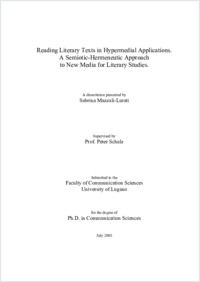Reading literacy texts in hypermedial applications : a semiotic-hermeneutic approach to new media for literary studies
- Mazzali-Lurati, Sabrina
- Schulz, Peter (Degree supervisor)
-
07.10.2003
423 p
Thèse de doctorat: Università della Svizzera italiana, 2003 (jury note: Magna cum laude)
New media
Literature
Semiotics
Hermeneutics
Act of reading
Hypertext studies
Humanities computing
Hypermedia design
Nuovi media
Letteratura
Semiotica
Ermeneutica
Lettura
Ipertesto
Studi umanistici e informatica
Progettazione ipermediale
English
Italian
Ranging between humanities and technological studies, this dissertation aims at clarifying what happens when literary texts we are used to read in a “book form” are transposed in hypertexts and hypermedia, namely which are the effects of this transposition on the act of reading the literary text. The work is based on an interdisciplinary approach, comprising a semiotic-hermeneutic perspective and a technological one. The leading research questions are “how does the reader interpret the signs composing hypertextual transpositions of literary texts?” and “which contribution and which difficulties these signs bring with as to the literary text’s comprehension?” These issues are investigated by analyzing seventeen hypertextual transpositions of different classical literary texts and by describing their two peculiar features, namely the logic of representation and the prominence of the second order representation. In the first part of the work both the methodology and the results of the analysis of the chosen examples of hypertextual transpositions are exposed. In the second part the concept of “logic of representation” and its effect on the act of reading the literary text are discussed. “Logic of representation” describes the fact that the literary text’s significance is highlighted for a great part through visual representations. In the third part the “prominence of the second order representation” and its effect on the act of reading the literary text are clarified. Hypertextual transpositions consist in a first order representation (the literary text), on which reading strategies representations are superposed, thus creating a second order representation. Because of multilinearity and absence of a canonical reading order (which are typical hypertext characteristics), in hypertextual transpositions it is essential that the represented reading strategies are adequate in respect to the user’s goal and task. Hyperlinks interpretation (discussed in the last chapter) is a key-point of this adequacy.
Situandosi tra studi umanistici e tecnologia, questa tesi mira a chiarire cosa succede quando testi letterari che normalmente leggiamo in forma di libro sono trasposti in ipertesti e ipermedia. Più precisamente, indaga gli effetti di tale trasposizione sull’atto di lettura del testo letterario. Il lavoro si basa su un approccio interdisciplinare che comprende una prospettiva semiotico-ermeneutica e una prospettiva tecnologica. Le domande di ricerca fondamentali sono “come sono interpretati dal lettore i segni che compongono le trasposizioni ipertestuali di testi letterari?” e “quali vantaggi e quali svantaggi portano questi segni nella comprensione del testo letterario?” Questi problemi sono affrontati attraverso l’analisi di diciassette trasposizioni ipertestuali di diversi testi letterari classici e attraverso la descrizione delle loro due caratteristiche fondamentali: la logica della rappresentazione e la preminenza della rappresentazione del secondo ordine. Nella prima parte del lavoro sono esposti sia la metodologia sia i risultati dell’analisi degli esempi di trasposizione ipertestuale scelti. Nella seconda parte sono discussi la “logica della rappresentazione” e il suo effetto sull’atto di lettura del testo letterario. Il termine “logica della rappresentazione” descrive il fatto che il senso del testo letterario è illuminato in gran parte attraverso rappresentazioni visive. Nella terza parte sono chiariti la preminenza della rappresentazione del secondo ordine e il suo effetto sulla lettura del testo letterario. Le trasposizione ipertestuali consistono in una rappresentazione del primo ordine (il testo letterario), su cui sono sovrapposte rappresentazioni di strategie di lettura, che creano una rappresentazione del secondo ordine. A causa della multilinearità e dell’assenza di un ordine di lettura canonico (tipiche degli ipertesti), in questi artefatti è indispensabile che le strategie di lettura rappresentate siano adeguate rispetto allo scopo e al compito dell’utente. Punto cruciale di tale adeguatezza è l’interpretazione dei link (discussa nell’ultimo capitolo).
- Language
-
- English
- Classification
- Language, linguistics
- License
-
License undefined
- Identifiers
-
- RERO DOC 4809
- URN urn:nbn:ch:rero-006-108591
- ARK ark:/12658/srd1318288
- Persistent URL
- https://n2t.net/ark:/12658/srd1318288
Statistics
Document views: 393
File downloads:
- Texte intégral: 242
